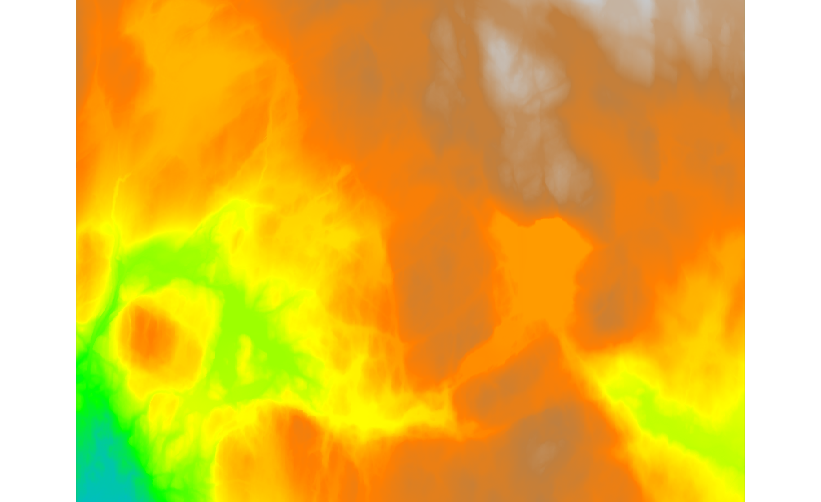Unit 19 - DSM script parallelization¶
This unit is focused on parallel computing. Sample script below produces seamless DSM (Digital Terrain Model, see Unit 18 - Lidar, DSM interpolation) from bunch of LAS/LAZ files. Computation will be split into tiles and performed in parallel.
DSM interpolation in parallel¶
User interface defines two parameters, directory (line 6) for input directory with input LAS/LAZ files, and elevation (line 9) name for output elevation raster map mosaics. The resolution of output DSM is defined by resolution parameter (line 13). And finally number of processes running in parallel will be controlled by nproc (line 18) parameter.
A script consists of three main functions:
1. import_files() to import input LAS/LAZ files (line
33). Import process can be performed in parallel by
ParallelModuleQueue from PyGRASS library (see
Unit 11 - PyGRASS scripting for PyGRASS introduction), lines 37, 42, 54-55, 57.
2. create_dsm_tiles() to compute DSM per tile (line 64)
using v.surf.rst. DSM tiles need to be computed with a
reasonable overlap in order to create seamless mosaics, see
70-73. Tiles can be processed in parallel too, see
nproc option on line 79.
3. patch_tiles() to patch DSM tiles together by
r.series, see 83. From overlapping cell values is
computed an average value. This is main reason why r.patch
is not used here.
1#!/usr/bin/env python3
2
3# %module
4# % description: Creates DSM from input LAS tiles.
5# %end
6# %option G_OPT_M_DIR
7# % required: yes
8# %end
9# %option G_OPT_R_ELEV
10# % description: Name for output elevation raster map mosaics
11# %end
12# %option
13# % key: resolution
14# % description: Output resolution
15# % type: double
16# %end
17# %option
18# % key: nprocs
19# % description: Number of processes per tile
20# % answer: 1
21# % type: integer
22# %end
23
24import sys
25import time
26from copy import deepcopy
27from pathlib import Path
28
29import grass.script as gs
30
31from grass.pygrass.modules import Module, ParallelModuleQueue
32
33def import_files(directory):
34 start = time.time()
35
36 # queue for parallel jobs
37 queue = ParallelModuleQueue(int(options['nprocs']))
38
39 import_module = Module('v.in.lidar',
40 flags='otb',
41 overwrite=True,
42 run_=False
43 )
44
45 maps = []
46 for fullname in Path(directory).glob('*.las'):
47 basename = fullname.name
48 # '-' is not valid for vector map names
49 # vector map names cannot start with number
50 mapname = Path(basename).stem.replace('-', '_')
51
52 maps.append(mapname)
53 gs.message("Importing <{}>...".format(fullname))
54 import_task = deepcopy(import_module)
55 queue.put(import_task(input=str(fullname), output=mapname))
56
57 queue.wait()
58
59 if not maps:
60 gs.fatal("No input files found")
61
62 return maps
63
64def create_dsm_tiles(maps, res, nprocs, offset_multiplier=10):
65 offset=res * offset_multiplier
66
67 for mapname in maps:
68 Module('g.region',
69 vector=mapname,
70 n='n+{}'.format(offset),
71 s='s-{}'.format(offset),
72 e='e+{}'.format(offset),
73 w='w-{}'.format(offset)
74 )
75
76 Module('v.surf.rst',
77 input=mapname,
78 elevation=mapname,
79 nprocs=nprocs,
80 overwrite=True
81 )
82
83def patch_tiles(maps, output, resolution):
84 gs.message("Patching tiles <{}>...".format(','.join(maps)))
85 Module('g.region', raster=maps, res=resolution)
86 Module('r.series', input=maps, output=output, method='average', overwrite=True)
87 Module('r.colors', map=output, color='elevation')
88
89def main():
90 start = time.time()
91
92 maps = import_files(options['input'])
93 create_dsm_tiles(maps,
94 float(options['resolution']),
95 int(options['nprocs'])
96 )
97 patch_tiles(maps,
98 options['elevation'],
99 options['resolution']
100 )
101
102 gs.message("Done in {:.0f} min".format((time.time() - start) / 60.))
103
104 return 0
105
106if __name__ == "__main__":
107 options, flags = gs.parser()
108
109 sys.exit(main())
Sample script to download: create-dsm.py
Note
The script is taking a long time with all the tiles from
lidar directory. Choose few tiles
for testing.

Fig. 104 DSM created from all available tiles.¶
Canopy Height Model¶
In this session we will compute the Canopy Height Model (CHM), as the difference between interpolated DSM and imported EU-DEM (DTM) from Unit 15 - Data reprojection.
The CHM is computed using r.mapcalc, executing the difference between DSM and DTM.
r.mapcalc expression="chm = dtm_laz - dem"

Fig. 105 The CHM map.¶
Task
Note that DSM created from Lidar data and EU-DEM have completely different qualitative characteristics. For a reasonable result it would be necessary to substitute DEM from another qualitatively similar source like DSM.